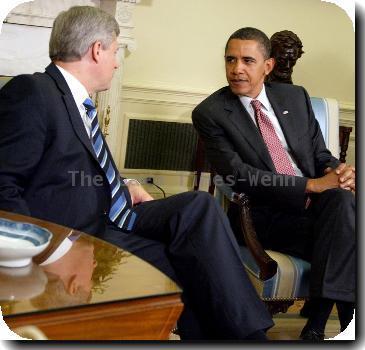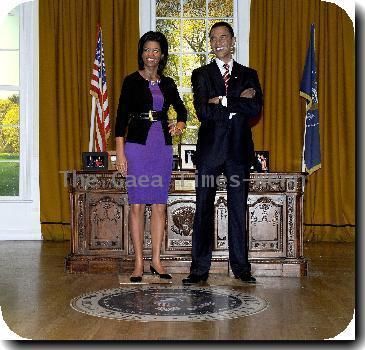Marine commander says NATO forces now control all key roads, access points to Marjah
By Alfred De Montesquiou, APThursday, February 18, 2010
US: NATO controls Marjah’s key roads, govt centers
MARJAH, Afghanistan — U.S. and Afghan forces have taken control of the main roads, bridges and government centers of the Taliban haven of Marjah, the top Marine commander in southern Afghanistan said Thursday, though he added that pockets of insurgents remain.
“I’d say we control the spine” of the town, Brig. Gen. Larry Nicholson told The Associated Press as he inspected the Marines’ front line in the north of the town. “We’re where we want to be.”
After six days of a massive NATO offensive, Marines and their Afghan counterparts succeeded in their initial military objectives, he said: They now control all access points into town, the government centers and the main markets, and the key roads that crisscross the 80-square-mile (200-square-kilometer) area.
As Nicholson spoke, bursts of heavy machine gunfire in the near distance highlighted that insurgents still hold terrain less than a mile (kilometer) away.
“Everyday, there’s not a dramatic change, it’s steady,” he said, noting that fighting continues to erupt.
The southern offensive in Marjah is the biggest since the 2001 U.S.-led invasion of Afghanistan, and a test of President Barack Obama’s strategy for reversing the rise of the Taliban while protecting civilians.
But the optimism in Marjah came as a NATO airstrike in the north missed a group of targeted insurgents and killed seven policemen and injured two instead, the Afghan Interior Ministry said.
A joint NATO-Afghan convoy came under attack Thursday afternoon in Kunduz province, and the allied troops called for an airstrike as they exchanged heavy fire, ministry spokesman Zemeri Bashary said.
Kunduz Gov. Mohammad Omar said the police had arrived on the scene to help track down the insurgents when they were killed.
A NATO statement acknowledged the report and said it was investigating the incident along with the ministry. In September, a NATO airstrike in Kunduz aimed at Taliban fighters ended up killing dozens of civilians.
Afghan President Hamid Karzai has repeatedly criticized the use of airstrikes and other long-range weaponry because of the risk of civilian casualties. NATO forces have scaled back use of the strikes as a result, only allowing strikes if they are certain there are no civilians in danger.
NATO has confirmed 15 civilian deaths in the Marjah operation — 12 of them from two rockets that hit a home on Sunday. Afghan rights groups say at least 19 have died.
Six NATO service members and one Afghan soldier have also been killed since the attack on the town, the hub of the Taliban’s southern logistics and drug-smuggling network, began Saturday.
On Thursday, U.S. Marines pummeled insurgents with mortars, sniper fire and missiles as gunbattles intensified during the day. Enemy fighters fired back with rocket-propelled grenades.
Senior Marine officers say they have intelligence showing that more than 120 insurgents have been killed since the fighting began, but Nicholson would not discuss that number. Afghan officials have said more than 40 militants have been killed.
However, “several hundred” fighters have probably regrouped and will try resist the Marines’ advance against their strongholds in the coming days, Nicholson added.
The increasingly accurate fire from snipers — and strong intelligence on possible suicide bomber threats — indicates that insurgents from outside Marjah are still operating within the town, he said.
But there were also pockets of calm Thursday. Some families could be seen coming back to their homes, their donkeys laden down with their belongings, in a sign that some civilians believed the fighting is over in zones secured by NATO troops.
Several storekeepers reopened their shops in the bullet-riddled bazaar in the northern part of town, as customers lined up to buy goods for the first time in nearly a week.
As Marines and Afghan soldiers press their offensive in Marjah, they have been forced to hold their fire because insurgents are shooting from inside or next to mud-walled compounds where civilians are present — and restraint slows their advance.
On Thursday, Brig. Gen. Mohiudin Ghori, Nicholson’s Afghan counterpart, condemned the insurgents’ use of women and children as human shields during the fighting.
“We’ve seen children terrified, crying in front of doorways,” just before a Taliban shoots from behind them, Ghori said. “It’s outrageous.”
One Marjah farmer said the Taliban forced their way into his home and used it to fire on the troops.
“We couldn’t do anything when one of them was forcing his way into our house. What could we do?” said Sayed Wakhan, a sunburned, middle-aged opium poppy farmer in northern Marjah.
But Wakhan, who spoke to reporters as he mixed mud to make repairs on his house, also said he didn’t trust the government forces who now occupy his neighborhood.
“I have suffered at the hands of police, and I don’t like the international forces coming into our area,” he spat out. His vitriol was a reminder of the tough job ahead for NATO and Afghan authorities in winning over locals used to an uneasy peace under the Taliban.
The troops have to go to great lengths to identify who the insurgents are. Marines stopped one man Thursday as he exited a compound from which they’d been receiving fire, but he had no weapon. So they ran a quick test on his hands and found gunpowder residue. Soldiers tied his hands behind his back and covered his face with a shawl while he sat cross-legged on the ground waiting to be hauled away.
Once the town of 80,000 people is secure, NATO plans to rush in civil administrators to revive schools, health clinics and electricity in hopes of winning public support to discourage the Taliban from returning.
NATO forces will help maintain security in Marjah at first, but the plan is to transfer that job to the Afghan army and police as soon as possible. That shift is key to starting the drawdown of U.S. and other NATO forces, which the Obama administration has promised will start in July 2011.
NATO’s top military officer said Thursday that Afghanistan’s military and security forces are on track to meet their goal of recruiting 300,000 troops by the end of 2011, though retaining those troops has been a challenge.
However, Adm. James Stavridis told reporters in Stuttgart, Germany, that the performance of Afghan troops in the Marjah offensive was encouraging.
They are “fighting hard,” said Stavridis, the supreme allied commander for Europe and the commander of the U.S. European Command.
In another sign of the difficulty that NATO faces in trying to reverse the rise of militants, eight Afghan army officers defected to the Taliban in eastern Afghanistan, a police official said.
The policemen abandoned their posts in central Wardak province’s Chak district and joined with Taliban militants in the area, Mirza Khan, deputy provincial police chief, said Thursday. He said one of the officers had previous ties with the Taliban. The incident is being investigated. Taliban spokesman Zabiullah Mujahid confirmed the defection.
Associated Press writers Rahim Faiez in Helmand province, and Tini Tran and Heidi Vogt in Kabul, contributed to this report.
Tags: Afghanistan, As-afghanistan, Asia, Barack Obama, Central Asia, Collateral Damage, Geography, Marjah, Municipal Governments, North America, United States

